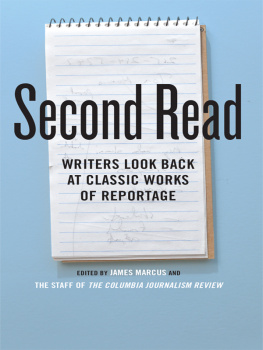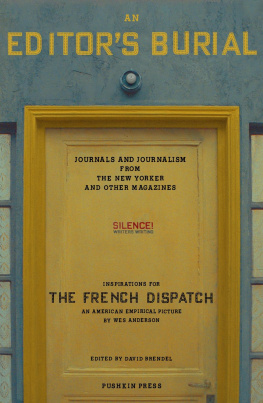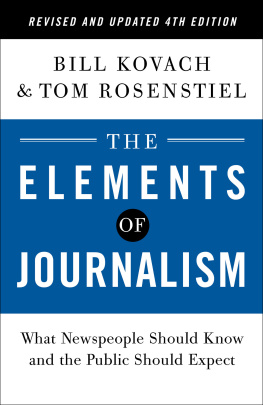Second Read
Columbia Journalism Review Books
SERIES EDITORS: VICTOR NAVASKY, EVAN CORNOG, AND THE EDITORS OF THE COLUMBIA JOURNALISM REVIEW
Second Read
Writers Look Back at Classic Works of Reportage
EDITED BYJAMES MARCUSAND THESTAFFOF THECOLUMBIA JOURNALISM REVIEW
COLUMBIA UNIVERSITY PRESSNew York
COLUMBIA UNIVERSITY PRESS
PUBLISHERS SINCE 1893
New York Chichester, West Sussex
cup.columbia.edu
Copyright 2012 Columbia University Press
All rights reserved
E-ISBN 978-0-231-50058-6
Library of Congress Cataloging-in-Publication Data
Second read : writers look back at classic works of reportage / edited by James Marcus and the staff of the Columbia Journalism Review.
p. cm.(Columbia journalism review books)
ISBN 978-0-231-15930-2 (cloth : alk. paper)ISBN 978-0-231-15931-9 (pbk.)ISBN 978-0-231-50058-6 (electronic)
1. American prose literature20th centuryHistory and criticism. 2. Reportage literature, AmericanHistory and criticism. 3. JournalismUnited StatesHistory20th century. I. Marcus, James, 1959 II. Columbia Journalism Review. III. Title.
PS366.R44S43 2012
818.508039dc23
2011020757
A Columbia University Press E-book.
CUP would be pleased to hear about your reading experience with this e-book at .
References to Internet Web sites (URLs) were accurate at the time of writing. Neither the author nor Columbia University Press is responsible for URLs that may have expired or changed since the manuscript was prepared.
Interior design by MARTIN N. HINZE
Contents


Curiously enough, Vladimir Nabokov once observed, one cannot read a book: one can only reread it. Nabokov, whose appetite for the delicious detail in any work of prose made him a ceaseless advocate of rereading, was mainly talking about fiction. But his comment applies equally to nonfiction.
The first time we read a great piece of reportage, we may be swept away by its narrative dash or fact-finding ardor. Only when we go back to it, days or years or decades later, do we discover its hidden charms. The second time through, we latch onto the reflexive, glinting irony in Peter Flemings Brazilian Adventure or the surrealistic touches in Gabriel Grcia Mrquezs The Story of a Shipwrecked Sailor. John McPhees Annals of the Former World suddenly seems a warmer work, less about auriferous gravels and more about the people who study them. And only in retrospect do we recognize Cornelius Ryans The Longest Day as a precursor of the New Journalistic fireworks that were to follow.
With these thoughts in mind, the Columbia Journalism Review launched its Second Read series in 2004. The idea was to get distinguished journalists to look back at the books that truly fired their imaginationthe books, often, that made them want to be journalists in the first place. We had no particular syllabus to construct: the authors chose their subjects on the basis of pure enthusiasm. Yet the essays gathered in this collection do amount to a snapshot history of mid-century American journalism (with a handful of chronological and geographical outliers). The major events and upheavals are all here, captured by many of the centurys most memorable voices: the Great Depression, World War II, the assassination of JFK, the ideological earthquake of the late sixties, the rise of environmentalism, and the perpetual skirmishing of identity politics.
Second Read also suggests a number of contrasting models for contemporary journalism. Should reporters be participants in the events they are covering, or even (if we are to follow the trails blazed by Tom Wolfe and Norman Mailer) characters in their own stories? Or should they stick to a more traditional conception of reportorial conduct, in which the journalist assembles a hoard of factual material without ever showing his or her hand? When Rachel Carson wrote Silent Spring, she was very much an advocate, and the same thing could be said of Palagummi Sainath, who set out to prick Indias communal conscience with Everybody Loves a Good Drought. But when A. J. Liebling zeroed in on Earl Longs electoral shenanigans, he seemed intent on suspending judgmenton presenting the florid facts and nothing more. As journalism enters a new century (and incidentally, as CJR celebrates its fiftieth year of publication, in 2011), there is no single, satisfactory path to follow. Instead there are many, and we hope this collection will function as something of a road map.

The Second Read series got under way with Rick Perlsteins essay on Paul Cowans The Tribes of America, which had been published in 1979 and out of print for decades. Here, argued Perlstein, was a penetrating study of Americas culture wars, written many years before that phrase was even coined. He gave Cowan plenty of credit for his prescience. He gave him even more credit for questioning his own cultural assumptions as a lefty correspondent for the Village Voice:
What Paul Cowan understood long before anyone else was that there was a new kind of story to tell about such conflicts: that attempts to coax people into the melting pot had costs as well as benefits, and [such] campaigns must not simply be imposed by fiat. Cowan understood how often people I might once have written off as reactionaries were fighting to preserve their cultural and their psychological and their physical turf, and that this new argument over the meaning of democracy was defining the next frontier of political conflict itself. That America had tribes, and that sometimesoftenthey would come to blows.
In this case, Perlstein not only drew attention to a neglected classic. He also inspired the New Press to usher The Tribes of America back into print in 2007, with his essay as an introduction.
Several other pieces in the collection perform a similar feat of rediscovery, shining a light on works that have fallen victim to shifts in literary taste or ideological fashion. There is, for example, John Maxwell Hamiltons essay on Vincent Sheeans Personal History. Sheean, a swashbuckling foreign correspondent of the old school, was a looming figure during the thirties. His memoir won the very first National Book Award for nonfiction in 1935 and ascended to the upper reaches of the pop-culture pantheon when Alfred Hitchcock adapted it (very loosely) for Foreign Correspondent in 1940. Yet Sheeans intensity, and his willingness not only to report but also to interpret the world for his readers, eventually fell out of style. Hamilton makes a powerful argument for his resurrection.
Claire Dederer is equally ardent about another lost classic of reportage, Betty MacDonalds Anybody Can Do Anything. In this case, the author is not a complete obscurity: her earlier memoir The Egg and I, as well as her childrens books, won her a fair measure of fame during the forties. But her chronicle of Seattle during the Great Depression, when she kept her family afloat with a succession of increasingly hardscrabble jobs, has long since fallen off the radar. Dederer praises it as a rough draft of history. The details of home and work life accrue, anecdotes pile up, and suddenly the reader has a real sense of daily existence in the West during the 1930s. This is a cheerful, unassuming way of documenting a socially and economically turbulent period. But its documentation nonetheless.
Readers will encounter similar advocacy from Robert Lipsyte (stumping for Paul Gallicos
Next page






